How To Repair Cracked Cast Iron
0
How to Set up Cast Iron Without Welding
Last Updated on
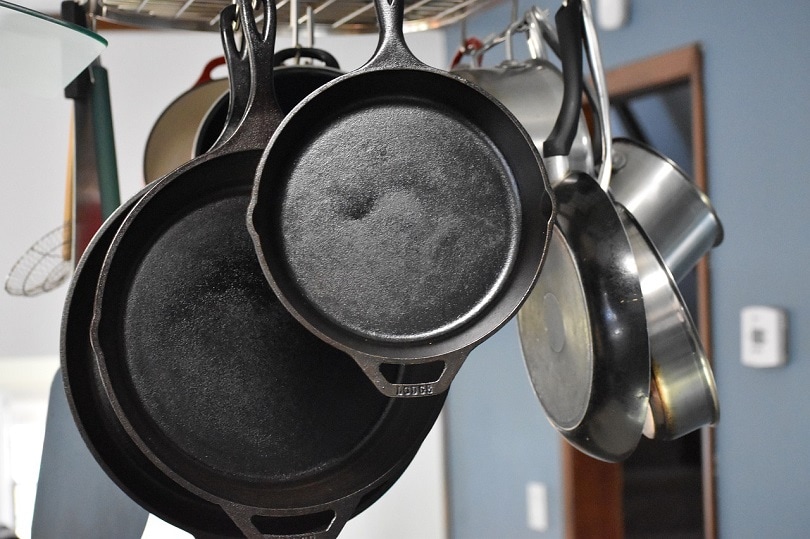
Cast iron is utilized in many industrial and household structures. It is a vital useful cloth used in a broad range of means, from stoves to engines. By nature, bandage iron is brittle. Notwithstanding, it can be susceptible to breaks and cracks if not well maintained. Cracks on bandage iron may exist brought virtually past thermal gradients, massive swings in temperature, and physical shocks resulting from dropping it on a rigid surface. It tin can be frustrating and stressful when your equipment made of cast iron cracks. Luckily, this can be fixed with less time and hassle.
Although yous tin can ready cast atomic number 26 pieces through welding techniques, it tin be challenging as you could stop upward causing further damage in the process. There are several platonic methods that you could apply to repair cast atomic number 26 that does not crave welding. Such techniques include brazing, the use of epoxy putty, and the utilize of common cold metallic stitching.
It is recommended that you use ideal methods when repairing your cast iron pieces. Using the wrong technique could cause further damage to your work, making it impossible to repair. Although welding is a usually preferred method to join pieces of metal, it may not be ideal for some cast iron pieces requiring some technicalities.
This piece will give you the much-needed insight into how you lot can fix cast atomic number 26 pieces without welding.
Permit's go to it.
How to Set Cast Atomic number 26 Through Cold Metal Stitching
Cold metal stitching is ideal for fixing cracked cast atomic number 26 that cannot exist repaired via conventional methods, such as welding. This technique implements specialized inserts that connect damaged metallic regardless of the nature of the crack. The dissimilar pieces of the bandage iron separated by the crack are laced up through common cold metallic stitching.
Cold metal stitching is a popular method, and information technology is an ideal repair solution for structures that cannot easily be replaced or dismantled. Construction workers can also utilise this method to restore old buildings to preserve the original architect and handiwork.
Different welding, this method is too suitable for repairing ships and railway road locomotives. When the send'due south engine blocks, rather than replace it with a new 1, you lot can employ the cold metal switching to mend it. This procedure is pop in construction, automotive industries, mining, large engine machinery, transportation, and many other essential applications.
The following is a stride-by-step process on how you can repair cast iron by common cold metal stitching.
ane. Diagnosis of the Cast Fe Crack
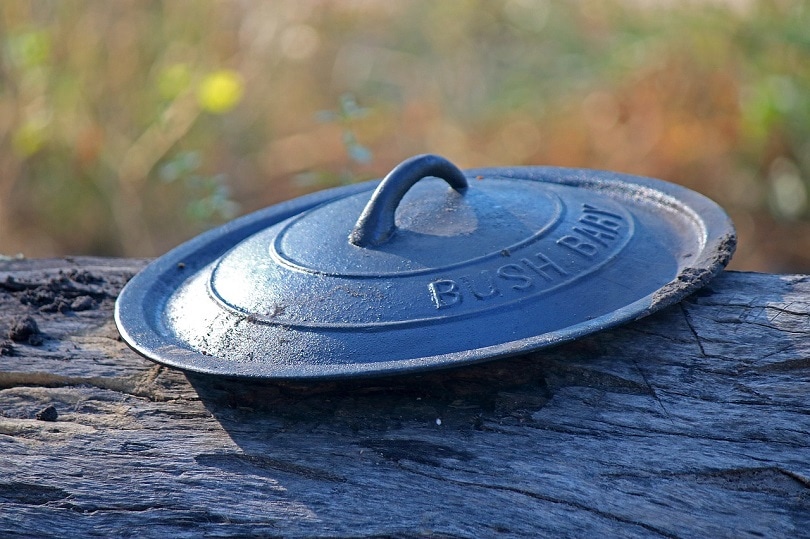
Credit: Bluesnap, Pixabay
Considering the fissure in question is the start stride in the procedure of cold stitching. This method is ideal for bandage iron pieces with a thickness of 3/sixteen inches upward to 1 pes. The length of the crack does not matter. The nature of the crack volition determine whether it can be fixed or you need to create another atomic number 26 cast piece entirely.
2. Drilling of the Holes
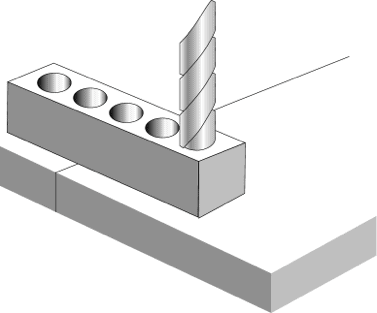
Prototype credit: Metalock International Association, Wikimedia Eatables CC 4.0
The second stride in the common cold metallic stitching procedure is drilling holes forth the crack. The holes should be spaced out at regular specified intervals. For best results, a guide is recommended for accurate drilling of the holes along the fissure. The set of the holes should not necessarily have the same number in total. The idea is to make stitching points that are strong to hold the cracked cast iron together.
three. Joining the Rows of Holes
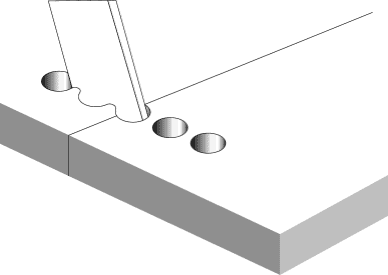
Epitome credit: Jpmort, Wikimedia Commons CC 4.0
After drilling the stitching holes, you will then be required to join them together. To strengthen the cracked cast iron, the holes volition arrive straightforward to insert the keys. You will demand a behemothic chisel to join the holes without creating a slot in the metal. The circular shoulders of the holes that have been drilled will serve every bit holding points when the keys take been inserted. Information technology is vital to maintain the outer diameter of the drilled holes while still joining them.
four. Inserting the Metal Stitches or the Metal Keys
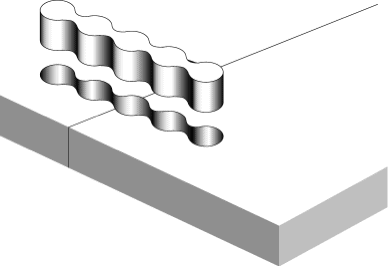
Epitome credit: Jpmort, Wikimedia Commons CC 4.0
The most vital component of this process is the metal keys. They offer the strength required in belongings the croaky parts together after the repair. High-strength metallic is significant in cold metal stitching. Otherwise, you will have to echo the procedure equally it may exist ineffective.
Ideally, the drilled holes in the beginning step should be of the same length equally the metal keys. By doing this, the metallic keys will add together much-needed strength across the unabridged surface of the cast atomic number 26, thus preventing further cracks from occurring. There should be a snug fit between the drilled holes and the metal keys to create a solid bail. At that place should be no play between the metallic keys and the original piece.
When in that location is excess cloth from the original part surface, you should not worry about dealing with the excess materials through the finishing process.
- See besides: How to Repair Wrought Fe without Welding
v. Sewing the Stitches Together

Image credit: Jpmort, Wikimedia Commons
It's non enough to depend on the inserted metallic keys in the cracked bandage iron piece. This is because they may not exist strong enough to withstand intense pressure and oestrus; thus, they may break. Thus, you will need to connect screws between the metal keys. Put them relatively shut to the neighboring screws and the metal stitching keys that you have installed. The bail between the repaired metal and the cracked bandage fe tin be more robust subsequently tightening the stitches.
Just as with the metal keys, it's okay if there is excess metallic that may exist sticking up from the screws that take been installed. The excess cloth will come in handy when finishing the surface; it will appear as ane whole cast iron piece. Lining up the affluent with the original cast iron piece's surface will assistance eliminate weak spots and the reoccurring scissure chances.
6. Removing the Excess Material
The final step of the cold metal stitching process involves chiseling away the excess fabric from the stitching screws and the metallic keys you've inserted. Using the chisel, remove as much metal material as you tin. A tool for grinding is then used to sand the rest downwards. Refinishing is vital as it helps to restore the cast fe piece as information technology was initially. The bear witness of repair must exist subconscious beneath the excess metal for a make clean outlook.
Use of Epoxy Putty to Repair Cracked Cast Iron
Proper maintenance of your bandage iron pieces should be done to forestall them from hands cracking. It would be all-time if y'all also kept it under dry conditions to preclude information technology from rusting. Yet, should any cracks occur, you tin can prepare the cast atomic number 26 pieces using epoxy putty using the following step past step process.
- Kickoff, buy epoxy putties such as Quick Steel or JB Weld at your local hardware store. These 2 types of epoxies will serve equally gum and volition adhere to cast iron and fill the crack with a condom seal.
- Using 80-grit sandpaper, sand the bandage iron to remove any paint and rust that might be covering the scissure. To avoid widening the scissure, use back and along move instead of circular movements. This procedure helps make clean the atomic number 26 cast surface by removing substances on top of the crack.
- Using a rag, water, and soap, thoroughly clean the cracks and the surface surface area. Before standing, allow the cast iron to dry out.
- While following the instructions of the manufacturer, stir the epoxy. Onto a flat surface, squeeze some out. Yous may utilize a putty knife and a scrap of cardboard to mix it.
- The mixture of the putty is and so spread into and over the cracked bandage atomic number 26. You should ensure that y'all scrape off the excess mix using a putty pocketknife before information technology dries. It is recommended that you wait for 24 hours before treatment the repaired bandage iron.
- The final step in repairing bandage fe pieces with epoxy putty is painting over the sealed crack. This helps to enhance durability and ensure that the repaired cracked part matches the rest of the bandage iron piece.
- See also: How to Fill Holes in Metal without Welding (Quick & Easy)
Use of Brazing to Gear up Cracked Cast Iron
Although cast iron is a rigid material, information technology is prone to breaks and cracks. Another constructive way the cracks tin can be stock-still without welding is brazing. Unlike the traditional welding technique used to repair metal items, brazing uses minimal heat to fix your cast iron pieces. This technique is unremarkably used to correct cracks on cast iron items.
The following is a stride by step guideline on how y'all can fix cracked bandage iron piece through the brazing method.
- A filler rod is selected depending on the awarding of the part of the cast iron. Filler bars that are used for brazing of cast iron are frequently made from brass or nickel. Some fabricators and metalwork specialists use filler confined with flux, while others prefer different flux during brazing.
- After choosing your preferred filler bar, you must prepare the crack surface on the cast iron piece. Before brazing, the surface of the crack must be thoroughly cleaned to remove oxides and impurities. Using a grinder, the crevice surface should be ground out to class a cantankerous-department that is U-shaped. This process allows the brazing material to avoid stress concentrations and fully menstruation into the crack.
- A stainless steel brush should be used to brush the basis expanse afterwards grinding the cast iron piece. This procedure helps to ensure that any particulate that was left after grinding is removed.
- The cast atomic number 26 office is and so supposed to be heated. Attempting to use a brazing torch on the bandage iron's cooler parts may cause further warping and cracking. Thus, other types of heat sources such as a weed burner, an oven, or a gas grill can be used to slowly heat the cast iron part.
- The piece of the bandage iron is and then placed onto a piece of work surface and braced if necessary. During the brazing process, some meaning parts may need heating, especially if the crack is substantial, and the process of brazing may take time. To maintain the temperature of the piece, information technology is recommended that you use an external heater.
- You lot are then required to heat the crack's surface by using a brazing torch to the point that information technology turns to bright ruby-red. The filler rod is then placed onto the crevice surface. For an effective brazing process, it is recommended that the surface temperature be extremely hot to enable the cloth of the filler bar to flow into the crack hands. While progressing down the crack, you lot may use the brazing torch to maintain the local temperature.
- Finally, place the repaired part into a container full of sand and embrace information technology entirely with sand. After the brazing procedure, the fixed amount of the cast atomic number 26 should be cooled very slowly. The bandage fe may crack if it's left out in the air to cool downwards. It is recommended that you leave the repaired part for at least one twenty-four hours in the sand and longer if the domain is significant.
How to Prepare Tour Cracked Cast Atomic number 26 Slice Earlier Repairing It
Buying a new cast iron piece may exist costly; thus, yous should consider repairing it. Once yous make up one's mind to repair your cast iron, regardless of the methods mentioned above that you may want to use, you should thoroughly make clean it to eliminate dirt, grease, and oxides.
The following is a guideline on how you could make clean bandage fe pieces earlier fixing them.
Autonomously from cracking, your bandage iron items may get rusty or burnt. If your cast iron piece is burnt, y'all could first outset by spilling salt on its surface. You tin can utilize a scrub or a soft brush to cleanse the surface. For more effective cleaning, it is ideal that you use a damp brush. However, you should use a plastic scraper if the burn is stubborn to eliminate burnt substances on the surface.
If your bandage fe piece is rusty, you may use a scrub and detergent to get rid of the rust. The rust could damage your cast iron detail if not eliminated on time. Seasoning may also be a remedy if the rusty levels are high.
Supposing your cast atomic number 26 item that has cracked is discolored, you may thoroughly scrub it with steel wool to remove any particles on information technology. This helps to eliminate any traces of dirt on your metallic slice. After scrubbing, wash your slice with soap and warm water and go out it to dry. The color of your bandage fe piece will be restored.
After your fe cast piece is clean and dry, you could grind it to eliminate defects such as porosity, making the cracked surface fix for repair.
Bottom Line
Cracked cast atomic number 26 is not the end of your slice; y'all can quickly repair it and restore it to its functionality. You practice non necessarily need to use welding. Some of the methods you could use to ready it include epoxy putty, cold metal stitching, and metal brazing following the procedures discussed to a higher place. With this, now you tin can get up and restore your cracked bandage fe effectively.
If you need to practice other bonding piece of work without welding, check out some of our other how-to guides beneath:
- How to Replace Rocker Panels Without Welding
- How to Bond Metal to Metal Without Welding
- How to Fill Holes in Metal without Welding (Quick & Easy)
Featured Image Credit: Ernest_Roy, Pixabay
- How to Fix Bandage Atomic number 26 Through Common cold Metallic Stitching
- i. Diagnosis of the Cast Atomic number 26 Scissure
- 2. Drilling of the Holes
- 3. Joining the Rows of Holes
- 4. Inserting the Metallic Stitches or the Metallic Keys
- five. Sewing the Stitches Together
- 6. Removing the Backlog Cloth
- Employ of Epoxy Putty to Repair Croaky Cast Fe
- Use of Brazing to Prepare Cracked Cast Iron
- How to Gear up Tour Croaky Cast Iron Slice Earlier Repairing It
- Bottom Line
Cameron Dekker
Cameron grew up in Allentown, Pennsylvania, a once-proud steel town on the Lehigh River, where he got a gustation of TIG welding in his high school shop class. He holds certificates for Certified WeldingEducator (CWE) and Certified Resistance Welding Technician (CRWT) from the American Welding Found. His interests include scuba diving, sculpture, and kayaking.
Source: https://waterwelders.com/how-to-fix-cast-iron-without-welding/
Posted by: kernlabon1943.blogspot.com


0 Response to "How To Repair Cracked Cast Iron"
Post a Comment